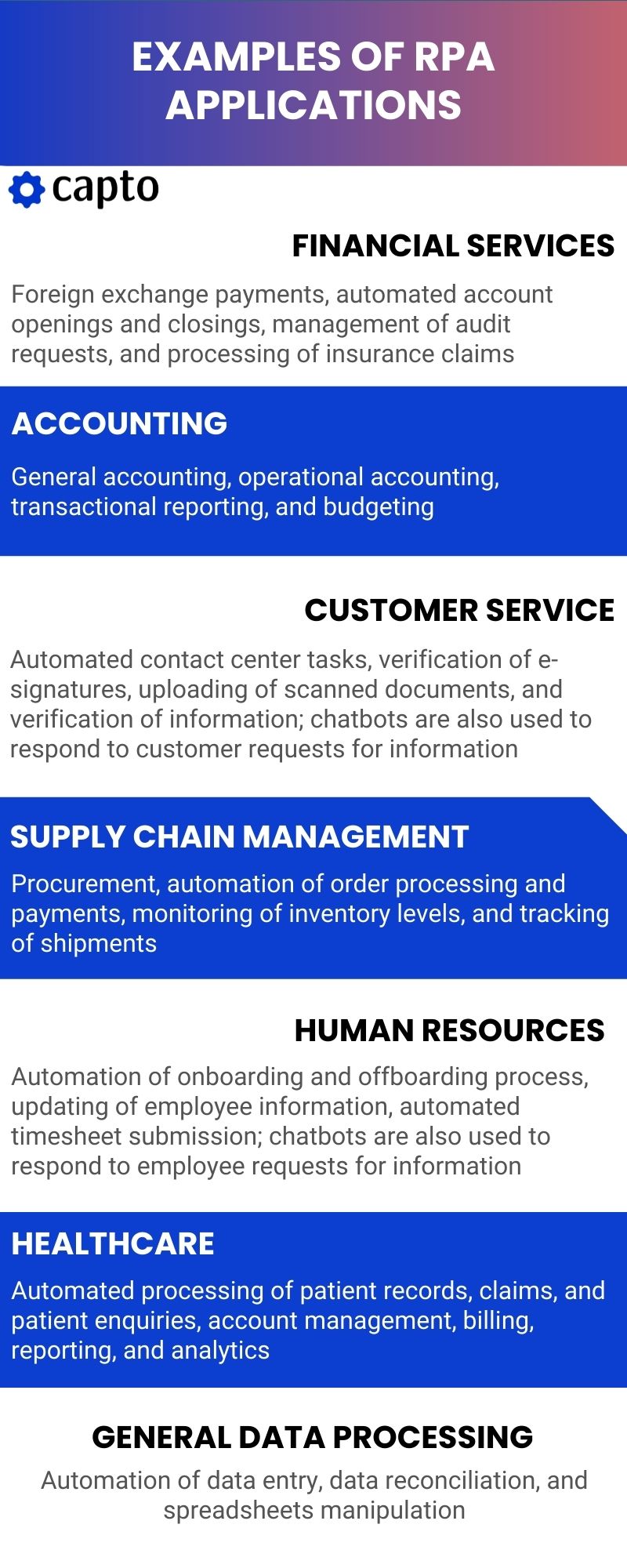6 Robotic process automation examples for scaling businesses
Scaling up your business requires selecting the right settings for your company’s digital workflows. Scaling depends on adapting quickly and synchronizing within a dynamic environment. However, if not planned well for the long term, you may, at some point, get overwhelmed, or lost, failing to achieve your business goals. By scaling, you want to stimulate sustainable growth as much as possible. Do you wish to scale your business easier? If the answer is yes, then this article is exactly for you.
Why use RPA for scaling your business?
The accelerating development of Robotic Process Automation has a huge potential to enable businesses to scale organically and sustainably. Each startup aims to reach the point where revenue is increasing without substantial growth in resources. As such, scaling comes as a result of the right planning and improved process workflows. However, the truth is that expansion contains risks.
Acquiring a bigger market share is essential, but it could also become a threat if it happens too fast at a given point. That is why organizations have to be prepared to avoid overloads and use technology to leverage risk. RPA is becoming widespread amongst scaling businesses because of the numerous opportunities for shifting rule-based mundane tasks from humans to digital workers. This opens up a growing room for team members to perform more creative activities, contributing to the company’s growth strategy.
In a previous article, we explained what the benefits of RPA are. However, in a nutshell, Robotic Process Automation is well-known for improving overall business efficiency across industries. It brings higher quality and consistency, saving time and money. It is also recognized as a powerful asset for increasing productivity among team members. This translates directly into scalable growth and higher profits for your company.
According to analyses performed by Deloitte, “only a tiny minority (3 percent) of progressive leaders have reached any form of scale with more than 50 robots in service. Organizations must make the right strategic choices—laying the right foundation to enable a “premium” digital workforce to support their drive for competitive advantage.” It is further suggested that “given the relative immaturity of the automation market, it is taking time for large organizations, in particular, to learn about and adopt RPA at scale.” This demonstrates the advantage startups have to make RPA a crucial part of their scale-up strategy as this would enable them to compete for market share with far larger but digitally immature organizations.
Top 6 RPA examples for scaling businesses:
We divided our list of RPA examples into six major sections based on the key business functions where software robots can help the most with the growth of your business. We hope this list will give you a useful overview of the practical applications of RPA to help you scale your business. Now let’s dive in.
You don’t have time to read the whole article right now? Download a free one-page infographic that summarizes the key details you need to know about RPA and its benefits and applications for scaling businesses. Download it here.
1. Customer Support & Client Onboarding
Common, yet, outstanding examples of RPA are the auto-responding to queries and auto-sending of notifications which are both essential for an effective customer support function. Nowadays, users require quick answers to their questions or instant help with problems that they face. A great part of these requests can be handled by RPA digital agents in a routine, standardized manner. This saves valuable resources for companies and improves customer satisfaction. For instance, Facebook has already automated most of its customer support. As a result, the human workload has substantially decreased, while customer satisfaction has gone up.
New client onboarding and new account openings are also processes easily handled by a robot. In addition, more and more often, a lot of scaling businesses delegate to software robots call center operations, including help desk services. In fact, RPA can take care of most of the common queries and repetitive issues. Robots effortlessly help agents by displaying a dashboard with suggested solutions and summarizing relevant information.
2. Accounting & Admin
Most administrative tasks like generating, preparing, and processing documents must be automated in each growing business today. For example, handling invoices is a fundamental task in accounting. It is also one of the most time-consuming processes that companies of all sizes have to tackle. The good news is that today digital workers can execute the entire process instead of humans, with zero interruptions and mistakes.
Creating and delivering invoices, like most rule-based activities, can be automated by linking accounting and ERP systems. By extracting data from submitted receipts robots can even handle the expense management process and generate expense reports. Essentially, all the data entry and manual work involved can be done by robots to make processes automated, paperless, and efficient.
3. Finance Operations
If deployed strategically within the finance function, robots are able to perform not only simple individual tasks but even finance sub-functions such as procurement and tax compliance. Surveys show that one robot can be up to 30 times more productive than a full-time working human. The truth is that the evolution of RPA in finance has reached the stage of full automation. This means that the opportunities for a scalable finance function range from simple everyday processes, such as bank reconciliations, to complex operations such as financial analysis and forecasting.
Common RPA use cases within finance:
- Transaction processing - approval, due diligence, and onboarding processes;
- Payroll operations - including changes in records, attendance management, time entry validations, resignation, and deductions;
- Bank statement reconciliation - extracting data from bank statements and comparing it to the company’s records;
- Issuing refunds - prompt refunds to customers requesting refunds;
Some enterprises are going a step further by automating requests for approval and as a result, are reducing their processing time by 75%. Banks, for example, automate their commercial lending processes by completing standardized data forms, which help them to accelerate new account opening and new client onboarding.
4. Human Resource Operations
- Candidate sourcing - pulling data from job search platforms, auto-reviewing applications, aggregating resumes, auto-scheduling meetings, taking notes from interviews;
- Hiring - comparing candidate data, assessing results, preparing paperwork such as HR contracts and agreements;
- Onboarding employees - ensuring compliance with Policy & Procedures by auto-sending relevant information like Welcome Materials, Company Guidelines, or Training Resources;
5. Sales Operations
One of the most fundamental challenges during the scaling phase is how to speed up the sales cycle with efficiency and precision. Speed is important but so is the accuracy of the pricing proposals, the sales contracts, the timely notifications, and follow-ups. These are all areas that require significant attention to detail in order to perform these routine administrative operations diligently and correctly. Software robots come in to support the sales process by handling numerous administrative tasks.
Common processes that should be automated within scaling businesses include:
- Preparation and delivery of accurate sale quotes;
- Checks of supplier portals to confirm availability and price;
- Preparation and updates of pricing models based on a pre-configured logic;
- Extraction of data from supplier portals and inserting it into pricing models;
- Preparation of sales contracts;
- Update of CRM systems;
- Interaction with ERP systems;
6. Compliance & Data-Related Operations
Statistics show that implementing RPA improves compliance accuracy by 93%. In the dynamic business environment, compliance is vital for each scaling business. For example, a change in tax or regulatory conditions would require numerous validations of records.
Here’s a list of data-related RPA use cases ensuring better compliance for scaling businesses:
- Check for completeness;
- Data entry from files to ERP;
- Read and process paper forms, and transfer them into digital forms;
- Annual tax return preparation;
- Filling in and submitting of compliance forms & returns;
- Check validity of VAT numbers via API;
- Copy and move data between systems;
- Generation of reports;
- Know-Your-Customer (KYC) and Anti-Money Laundering (AML) checks;
Download a free one-page infographic that summarizes the key details you need to know about RPA and its benefits and applications for scaling businesses. Download it here.
Conclusion
Technological advances have made intelligent automation possible across a wide spectrum of manual processes. Scaling companies should strategize on how to optimize operations to meet business and investor goals and stay on track. By implementing RPA, you can build scalable processes and optimize business resources to make sure budgets last longer and human capacity is invested in value-adding business functions.
However, when it comes to adopting RPA for scaling, insecurities still prevail in most companies. That is why RPA continues to be overlooked despite its fundamental benefits. So, it is crucially important that decision-makers continuously dedicate time to identifying processes within their business that could and should be automated to achieve a scalable future.
At Capto, we believe automation should be implemented gradually and strategically. Our team has automated many processes already and we’d happily suggest RPA solutions that are flexible and tailored to your company’s scale-up needs. If you are looking to scale your business, meet investor goals, and make your resources last longer, then have a chat with us. We are here to help you leverage automation to drastically save time & resources and grow with scalable processes.
Let's chat about automation for 15 min
We'd love to help you with your questions so you can make the best decision for your business.
Sources & references:
1. Deloitte. https://www2.deloitte.com/us/en/pages/operations/articles/global-robotic-process-automation-report.html
2. Forbes. https://www.forbes.com/sites/marksettle/2020/10/20/the-proper-path-to-achieving–automation-at-scale/?sh=538509922a4a
3. Bernard Marr. https://bernardmarr.com/10-amazing-examples-of-robotic-process-automation-in-practice/
4. Gartner. https://www.gartner.com/en/finance/insights/robotics-in-finance
5. AI Multiple. https://research.aimultiple.com/robotic-process-automation-use-cases/
6 Robotic process automation examples for scaling businesses Read More »


